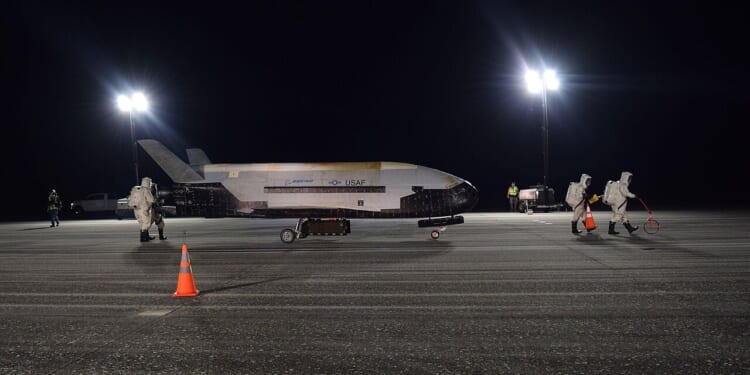The Space Force rarely discusses the X-37B—but it can rapidly change orbits, deploy payloads, or conduct on-orbit servicing, giving it clear intelligence or counter-space value.
The Boeing X-37B is a secretive and intriguing aerospace program. Ostensibly, the X-37B is a small and unscrewed reusable spaceplane bearing outward resemblance to the Space Shuttle. But unlike the famed Space Shuttle, the X-37B serves an entirely different mission profile—much of which is classified and mysterious, fueling speculation about the nature of ongoing US space operations.
The X-37B Orbital Test Vehicle’s Specifications
- Year Introduced: 2010
- Number Built: 2 (OTV-1 and OTV-2)
- Length: 29 ft 3 in (8.9 m)
- Wingspan: 14 ft 11 in (4.5 m)
- Weight (Launch Mass): ~11,000 lb (≈5,000 kg)
- Engines / Propulsion: Single hypergolic orbital maneuvering engine (hydrazine-fueled) + reaction control thrusters; launches via expendable rocket (Atlas V or Falcon 9)
- Top Speed (Reentry): ~Mach 25 (orbital velocity)
- Orbit: Low Earth Orbit (LEO), altitude ~200–750 km; variable inclinations (classified specifics)
- Range: Global (reusable, can land at multiple designated runways)
- Endurance: Capable of long-duration autonomous flights — record ~908 days in orbit
- Loadout: Internal bay (~7 ft × 4 ft; ~2.1 m × 1.2 m) for small satellites, experiments, and technology demonstrations; deployable solar array for power
- Aircrew: 0 (uncrewed robotic spacecraft)
What (Little) We Know About the X-37B’s Mission
Officially designated the Orbital Test Vehicle (OTV), the X-37 program began in 1999 under NASA as a testbed for reusable spacecraft technologies, ie., advanced thermal protection, autonomous reentry, and lightweight composite structures. But in the mid-2000s, the project was transferred to the Defense Advanced Research Projects Agency (DARPA) and later the US Air Force (and later the US Space Force), shifting the program firmly into the national security realm.
Physically, the X-37B is just 29 feet long, with a wingspan of 15 feet—roughly the quarter the size of the Space Shuttle. Inside, a cargo bay about the size of a pickup truck bed can host small satellites, materials experiments, or prototype payloads. Launched vertically atop a Falcon 9 or Atlas V rocket, the X-37B lands horizontally on a runway. And from launch to landing, the X-37B is fully autonomous.
In orbit, the X-37B opens its payload bay doors, deploys a solar array, and begins months—or even years—of on-orbit operations. Its orbit is low Earth orbit (LEO), but the exact parameters (altitude, inclination, duration) are not released to the public and often vary from mission to mission. What is known is that the vehicle can change orbits, maneuver extensively, and stay aloft for extraordinarily long periods; some missions have exceeded 900 days in orbit. After completing its classified mission, the X-37B autonomously reenters the atmosphere, glides to a conventional runway landing, and can be refurbished for reuse.
Because the Air Force and now the Space Force release few details about payloads or mission objectives, speculation about the program is intensive, and derives mostly from observed behavior. Assumptions hold that the X-37B likely tests new sensors, materials, and space-based technologies against the harsh radiation and thermal conditions of space. The platform may also be used to test mini-satellites or inspection capabilities, meaning it could deploy, retrieve, or inspect other orbit objects.
The X-37B Is the Ideal Vehicle for the US Space Force
The X-37B blurs the line between civilian and military spaceflight. While officials describe it as a research and experimentation platform, the vehicle combines stealthy operations, maneuverability, and reusability—giving it clear strategic potential.
The Space Force rarely discusses the X-37B in a military context. Yet a vehicle capable of rapidly changing orbits, deploying payloads, or conducting on-orbit servicing would absolutely have intelligence or counter-space value. And as space becomes more crowded, and more contested, the X-37B’s presence in orbit serves as a reminder that the US can operate with persistence and flexibility.
Essentially, the X-37B is a robotic, military space shuttle, capable of spending years in orbit and performing missions that remains mostly undisclosed. In the future, the program will likely be remembered as a bridge, a moment of transition in which space operations were militarized, when space vehicles became reusable, maneuverable—not just symbolic tools but overt tools for national power.
About the Author: Harrison Kass
Harrison Kass is a senior defense and national security writer at The National Interest. Kass is an attorney and former political candidate who joined the US Air Force as a pilot trainee before being medically discharged. He focuses on military strategy, aerospace, and global security affairs. He holds a JD from the University of Oregon and a master’s in Global Journalism and International Relations from NYU.
Image: Wikimedia Commons.















